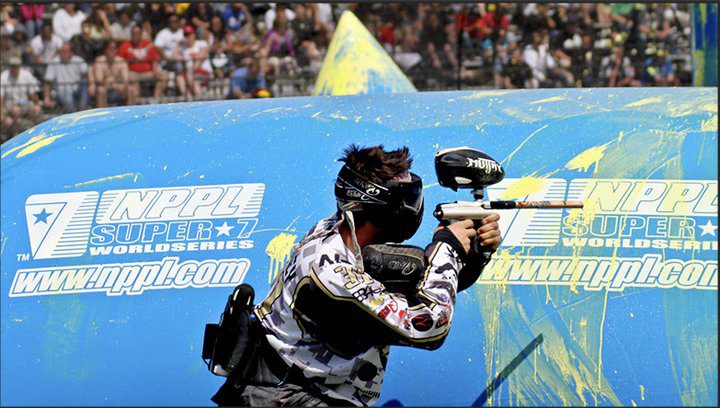Paintball invented a whole new way to experience team sports and strategic combat when it burst onto the scene. This exciting game, blending physical challenge with tactical play, has evolved from a quirky pastime into a widely recognized sport and recreational activity.
As a seasoned enthusiast and expert, I’ve seen firsthand how paintball’s unique blend of action and strategy captivates players of all ages and backgrounds.
Tracing back to its origins reveals not just a game, but a fascinating story of innovation and community.
Paintball’s journey began in the 1980s, born from a simple yet ingenious idea to mark trees with paint. This concept quickly escalated into a thrilling outdoor sport that demands both physical agility and sharp thinking.
The initial days, marked by the creation of the first paintball marker, laid the groundwork for what would become a dynamic and growing sport, illustrating the creativity and drive of its founders.
As we explore the history and evolution of paintball, we uncover the layers that contribute to its enduring appeal.
The Inception of Paintball
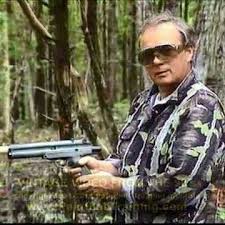
The story of paintball’s inception is a tale of innovation driven by a simple curiosity: could a marking gun be used for a survival game in the woods?
This idea was conceived during a conversation between Hayes Noel, a stock trader, and Charles Gaines, an outdoor enthusiast and writer. The duo, intrigued by the concept of testing survival skills in a recreational setting, quickly set the wheels in motion to bring this concept to life.
In the early 1980s, Noel and Gaines enlisted the help of Bob Gurnsey, who created the rules for what would be the first-ever paintball game.
The trio sourced oil-based paint marking guns from a farm catalog—originally intended for marking trees and livestock—which later evolved into the first paintball markers.
The very first game of paintball took place in June 1981 in New Hampshire, featuring twelve players competing in a “capture the flag” style game across an 80-acre wooded area.
This inaugural match not only tested their survival tactics but also marked the birth of paintball as a sport.
This experimental game proved to be a huge success, sparking interest and enthusiasm among participants and observers alike.
The foundational concepts laid down by Noel, Gaines, and Gurnsey established paintball as a viable sport, leading Gurnsey to develop and sell the first commercial paintball kit, which included the marker, paint, mask, and manual.
This kit helped to standardize the equipment and rules, paving the way for the sport’s future growth and the development of a dedicated following.
When Was Paintball Invented?

The concept was initially conceived in 1981 by Hayes Noel, Charles Gaines, and Bob Gurnsey.
The timeline of paintball’s invention centers around a few key dates.
1981
The first ever game of paintball was organized and played on June 27, 1981, in New Hampshire. This game featured twelve players who competed in a “capture the flag” format across an 80-acre plot of woodland.
The players used a “Nel-spot 007” pistol, a marker originally used by farmers and ranchers for marking trees and livestock.
Post-1981 Game
Following the success of the initial game, Bob Gurnsey quickly moved to capitalize on the burgeoning interest.
By the end of 1981, Gurnsey had created the first commercial paintball kit called the “National Survival Game,” thereby providing a structured way to play and equipment to use, which included the marker, paintballs, and protective gear.
Early 1980s
The sport gained traction rapidly, with enthusiasts from different parts of the United States starting to adopt and modify Gurnsey’s initial rules and equipment.
This period also saw the development of the first dedicated paintball field in 1982, which helped formalize paintball as a sport and recreational activity.
These early events in the early 1980s laid the foundational framework for what would become a popular sport worldwide.
From these modest beginnings, paintball has grown to feature highly organized competitions and sophisticated equipment, evolving from a simple survival game into a complex sport with a wide following.
Who Invented Paintball?
Hayes Noel, Charles Gaines, and Bob Gurnsey invented paintball.
But the birth of paintball as a sport can be attributed to several key individuals who played pivotal roles in its creation and early development.
These pioneers not only conceptualized the idea but also took practical steps to turn their vision into a recreational reality.
Here are the main figures responsible for inventing paintball.
Hayes Noel
A Wall Street stock trader, Noel was one of the original thinkers behind the idea of using marking guns for a survival game.
His conversation with Charles Gaines about whether a city slicker could survive against a countryman in the woods was the spark that eventually led to the first paintball game.
Charles Gaines
An outdoorsman and writer, Gaines brought the concept of survival and adventure into the initial discussions with Noel. His enthusiasm for testing survival skills in a competitive format was crucial in shaping the initial idea into a playable game.
Bob Gurnsey
Often credited as the “Father of Paintball,” Gurnsey wrote the rules for the first paintball game and organized the first-ever match.
Following the success of that game, he went on to create the first commercial paintball kit, known as the “National Survival Game,” which helped establish a standardized set of equipment and rules for the sport.
Caleb Strong
A friend of Noel and Gaines, Strong was instrumental in the initial testing and development phases. He was one of the original twelve players in the first game and provided crucial feedback that helped refine the game’s structure and rules.
Bob Jones and Jeff Perlmutter
These two individuals also played significant roles as early adopters and promoters of the sport. Jones, an outdoor sports enthusiast, and Perlmutter, who worked in a ski shop, saw the potential of paintball and helped spread its popularity through articles and promotions.
Together, these founding fathers not only invented paintball but also nurtured it from a conceptual survival challenge into a structured sport.
Their collective efforts in organizing the first games, creating the necessary equipment, and promoting paintball to a broader audience were instrumental in establishing paintball as a popular and enduring sport.
The Evolution of Paintball Equipment
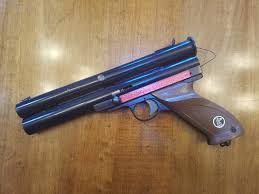
The evolution of paintball equipment, particularly the development of the paintball marker, is a testament to the sport’s growth from a simple concept into a sophisticated competitive activity.
The journey from the first paintball marker to today’s advanced models illustrates significant advancements in technology and design, enhancing both the safety and the experience of the sport.
The First Paintball Marker
The very first device used in paintball was not originally designed as a weapon but as a tool. The “Nel-spot 007” was a marker used by farmers and ranchers to mark trees and livestock.
This pistol-like device, which used oil-based paint in a gelatin shell, was manufactured by the Nelson Paint Company.
The initial adaptation of this marker for the sport involved loading the oil-based paint capsules individually into the barrel.
The Nel-spot 007 was a bolt-action marker, meaning that after each shot, the user had to manually cock the marker to fire again, which was slow and cumbersome in the fast-paced setting of a game.
Technological Advancements
As paintball gained popularity, the demand for more specialized equipment led to significant innovations. The development of the first marker specifically designed for paintball was a game-changer.
This was the “Splatmaster,” introduced in the mid-1980s. It was more robust and user-friendly for the sport, featuring a quicker and simpler semi-automatic operation that did not require manual cocking after each shot.
The introduction of CO2 cartridges as a power source replaced manual pump-action markers, allowing for rapid firing and improved game dynamics. This innovation greatly increased the speed and intensity of gameplay.
Modern Paintball Markers:
Today’s paintball markers are highly sophisticated, offering features such as electronic triggers, adjustable firing rates, and high-pressure air systems for improved consistency and accuracy.
Modern markers also come with extensive customization options, allowing players to modify their equipment with various barrels, hoppers, and grips to suit their playing style and improve performance.
Also Read: The Best Paintball Guns Today
Safety and Regulatory Improvements
Alongside the development of the markers, there has been a significant evolution in safety equipment, such as masks, goggles, and protective clothing. Modern safety gear is specifically designed to protect players from high-velocity paintballs and ensure that the sport can be enjoyed safely.
The industry has also seen standardization in terms of equipment specifications and game rules, guided by various sports organizations that oversee the safety and fairness of paintball as a competitive sport.
The evolution of paintball equipment from the rudimentary Nel-spot 007 to today’s advanced, electronically enhanced markers reflects the sport’s journey from a novel recreational activity to a serious competitive sport.
This progression not only underscores the innovative spirit within the paintball community but also highlights the commitment to enhancing player experience and safety.
Paintball Through the Decades: A Historical Timeline
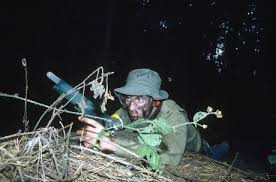
Paintball has enjoyed a dynamic and colorful history since its inception, evolving through several decades from a rudimentary game of survival to a globally recognized sport with a well-defined competitive structure.
Here’s a historical timeline that outlines major milestones and the evolution of the game.
1981 – The Birth of Paintball
Paintball officially began on June 27, 1981, in New Hampshire. Hayes Noel, Charles Gaines, and Bob Gurnsey organized the first game, which used the Nel-spot 007 paintball marker, initially intended for marking trees and livestock.
1982 – Establishment of the First Commercial Paintball Field:
Following the sport’s initial success, the first commercial paintball field opened in Rochester, New York. This development provided a structured environment for the sport to grow and become more accessible to the public.
1983 – The First Paintball Championship:
The National Survival Game hosted its first official paintball championship, marking the beginning of competitive paintball. This event showcased paintball’s potential as a competitive sport.
1985 – Introduction of the Splatmaster:
The Splatmaster, the first paintball marker designed specifically for the sport, was introduced. This marker was easier to use and more reliable than previous models, significantly influencing the game’s popularity.
1990s – Expansion and Technological Advancements:
Throughout the 1990s, paintball experienced rapid expansion both domestically and internationally. This decade saw significant technological advancements in paintball equipment, including the development of semi-automatic and electronic markers.
2000s – Mainstream Recognition and Organizational Development:
Paintball continued to gain mainstream recognition, with increased media coverage and the establishment of professional leagues and tournaments worldwide.
Organizations like the National Professional Paintball League (NPPL) and the Paintball Sports Promotions (PSP) helped standardize rules and promote the sport on a global scale.
2010s – High-Definition Broadcasting and Technological Integration:
Advances in technology allowed for high-definition broadcasting of paintball tournaments, increasing the sport’s visibility and spectator appeal.
The integration of electronic scoring systems and real-time data analysis further professionalized the sport, improving both gameplay and spectator experience.
2020s – Adaptation and Continued Growth:
The COVID-19 pandemic posed challenges, but paintball adapted with increased safety protocols and the implementation of more regionalized competitions to reduce travel.
Today, paintball remains a popular sport with a dedicated following, continuous innovation in equipment technology, and a strong community that spans the globe.
This timeline illustrates not only the key developments in the history of paintball but also highlights how innovations in equipment and the establishment of formal competitions have shaped the game.
Paintball has matured into a sport that combines physical endurance, strategic thinking, and team dynamics, making it unique in the world of recreational activities and competitive sports.
Significant Paintball Games and Their Impact
Throughout its history, paintball has seen several significant games that not only captivated players and spectators but also played pivotal roles in shaping the sport’s development, rules, and equipment. These key matches highlighted the strategic depth and excitement of paintball, helping to drive its popularity and spur innovations within the sport.
The First Official Paintball Game (1981)
The very first game of paintball, played in New Hampshire in 1981, is undeniably the most significant. It was a “capture the flag” scenario involving twelve friends, using the Nel-spot 007 pistols.
This inaugural match proved the viability of paintball as a recreational activity and laid the foundation for structured gameplay.
The National Survival Game Championship (1983)
As one of the earliest formal competitions, this championship marked paintball’s transition from a backyard pastime to a competitive sport.
The event attracted broader attention and demonstrated paintball’s potential for tournament play, influencing the standardization of rules and the adoption of safety measures.
The First World Cup (1992)
Held in Orlando, Florida, the first Paintball World Cup was pivotal in establishing paintball as a global sport. It brought together teams from around the world, showcasing international talent and fostering a sense of community and competition that transcended national boundaries.
The Introduction of X-Ball (2003)
X-Ball was introduced as a new format at the 2003 PSP (Paintball Sports Promotions) World Cup.
This format featured timed matches and point scoring, which added a dynamic aspect to tournaments, making games more exciting and spectator-friendly. X-Ball was influential in promoting paintball on television and attracting sponsorships.
The Millennium Series European Events (2000s)
These events significantly impacted the sport’s popularity in Europe. The series introduced new technologies, such as electronic markers and air bunkers, which were quickly adopted worldwide.
These innovations made the game faster and more appealing to a younger audience, influencing equipment standards globally.
The NXL (National Xball League) Championship Games (2015-onwards)
The reformation of NXL brought a renewed focus on professional paintball, with high-profile events that emphasized media coverage and live broadcasts.
These games have been crucial in maintaining paintball’s visibility and appeal in the digital age, integrating advanced broadcasting technologies and social media to reach a broader audience.
Each of these significant games and formats contributed to the evolution of paintball by testing and refining the rules, enhancing the equipment, and improving the overall competitive experience.
They helped transform paintball from a novel activity into a serious sport with a dedicated following and a professional ethos.
Also Read: The National Xball League
Paintball Culture and Community
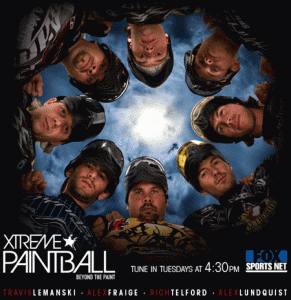
Paintball has not only evolved as a sport but has also cultivated a vibrant and diverse community that spans across competitive and recreational spheres.
This community is characterized by a shared passion for the game, a commitment to sportsmanship, and a culture of continuous improvement and innovation.
Recreational Play
At the grassroots level, recreational play forms the backbone of the paintball community. Local fields and parks offer weekend warriors a chance to escape the daily grind and engage in adrenaline-pumping action.
These venues foster a friendly, inclusive environment where players of all skill levels can participate. Family outings, birthday parties, and corporate events are common, making paintball a popular activity for bonding and social interaction.
Recreational play often emphasizes fun and camaraderie over competition, making it accessible and welcoming to newcomers.
Competitive Scene
On the competitive front, paintball boasts a well-organized scene with leagues and tournaments that cater to various skill levels, from amateur to professional.
These events are structured, with defined rules and formats, such as speedball, woodsball, and scenario games, each offering a unique challenge and requiring different strategies.
The competitive scene has helped elevate the sport’s profile, drawing players who thrive in a high-stakes environment and aspire to elevate their skills to the highest levels.
Cultural Impact
The culture of paintball is rich with traditions and values that emphasize honor, integrity, and respect. Players often share a “code of honor,” which includes calling oneself out after being hit, regardless of whether a referee notices it or not.
This code fosters a sense of fair play and mutual respect among participants, which is a cornerstone of the community.
Community Engagement
Paintball players tend to be highly engaged in their community, often participating in online forums, social media groups, and local clubs where they share experiences, discuss equipment, and plan events.
These digital platforms enhance the sense of community, allowing members to connect with one another, share tips, and stay updated on events and innovations.
Support for New Players
Experienced players and enthusiasts typically take active roles in nurturing new talent, offering guidance on playing techniques, safety protocols, and equipment maintenance.
Many local fields offer beginner clinics and rental equipment, making it easy for new players to try the sport safely and affordably.
Charitable Activities
The paintball community also engages in various charitable activities, organizing fundraising events and charity matches. These events highlight the community’s commitment to giving back and using their passion for the sport as a force for good.
In conclusion, the paintball community is a dynamic and thriving network of individuals who share a deep passion for the sport.
Whether through recreational play that brings families and friends together, competitive matches that hone skills and strategy, or community activities that foster engagement and charity, paintball offers a rich and rewarding experience to all its participants.
This vibrant culture ensures the sport’s continued growth and enduring popularity.
The Future of Paintball
As paintball continues to grow in popularity and evolve technologically, the future of this dynamic sport looks both promising and exciting.
Several trends and developments suggest new directions that paintball might take in the coming years, incorporating advanced technology, expanding its audience, and enhancing player experiences.
Technological Advancements
One of the most significant areas of growth will likely be in the technological enhancement of equipment. Paintball markers are expected to become even more precise and efficient, with improvements in areas like air efficiency, rate of fire, and weight reduction. Additionally, augmented reality (AR) could revolutionize how the game is played by integrating virtual elements directly into the physical gameplay environment, providing a more immersive experience.
Expansion of Virtual and Simulated Environments
With the rise of virtual reality (VR) and simulation technologies, there could be an increase in virtual paintball arenas, allowing players to engage in the sport from anywhere in the world. This would make paintball more accessible to those who cannot participate in traditional outdoor settings, potentially broadening the sport’s appeal and demographic.
Increased Professionalization and Commercialization
As the sport continues to mature, further professionalization of competitive paintball is likely. This could mean more corporate sponsorships, televised tournaments, and professional teams. With increased media coverage and financial backing, paintball could reach new heights of popularity and recognition as a legitimate sport.
Enhanced Safety Measures
Safety will continue to be a priority as the sport evolves. Innovations in protective gear that offer better protection while maintaining comfort and mobility will be key. Developments might include lighter, more durable materials for masks and body armor, as well as integrated communication systems within helmets for improved team coordination.
Sustainable Practices
Environmental considerations will also influence the future of paintball. As awareness of environmental impact grows, the industry may shift towards more sustainable practices, such as biodegradable paintballs and more energy-efficient air systems. Fields and arenas might also implement sustainable designs that minimize ecological footprints while maximizing player experience.
Community and Cultural Expansion
The paintball community is likely to become even more global and inclusive. We might see a greater emphasis on youth leagues, women’s leagues, and international competitions, fostering a diverse and inclusive culture within the sport. Community-building activities and outreach programs can help paintball reach a broader audience, promoting it not just as a sport but as a tool for education and personal development.
Integration with Other Media
Collaborations with other forms of media, such as video games and movies, could also occur, where paintball is featured more prominently in mainstream entertainment. This cross-promotion would help paintball reach wider audiences and integrate more deeply into popular culture.
Overall, the future of paintball appears to be one of growth and innovation, with advancements in technology and a deeper integration into sports culture globally. As these changes unfold, paintball will likely continue to offer an exhilarating and engaging experience for new and seasoned players alike.
Keep Reading: The Greatest Paintball Players
Conclusion to Paintball Invented
Paintball has journeyed from a novel concept in 1981 to a globally celebrated sport, attracting enthusiasts who cherish both the thrill of the game and the community it fosters.
From its humble beginnings with homemade equipment in the woods of New Hampshire, paintball has evolved into a sophisticated sport with specialized gear, professional leagues, and a dedicated global following.
This evolution reflects not only advancements in technology but also a growing appreciation for the sport’s unique blend of strategy, physicality, and camaraderie.
For enthusiasts around the world, paintball is more than just a recreational activity; it’s a passion that builds lasting friendships and teaches valuable skills like teamwork, strategy, and leadership.
As the sport continues to grow, it promises to bring even more innovative features and opportunities for players of all levels.
Paintball remains a vibrant and dynamic sport that continues to captivate and challenge players, ensuring its place in the world of competitive and recreational sports for years to come.
